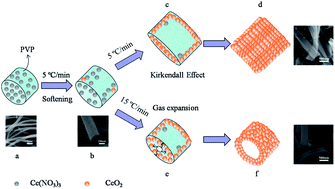Morphology adjustment of one dimensional CeO2 nanostructures via calcination and their composite with Au nanoparticles towards enhanced catalysis
Abstract
One dimensional (1D) CeO2 nanostructures have been successfully fabricated via a single nozzle electrospinning method and subsequent two-step calcination route by adjusting heating rates. The formation process of CeO2 nanotubes (NTs) and nanobelts (NBs) was investigated by observing the morphology evolution of fibers during calcination. Control of the heat-treatment procedure including solvent evaporation, the Kirkendall effect, polymer softening, and thermal decomposition of poly(vinylpyrrolidone) plays an important role in the morphologies of the samples. Well-dispersed and small Au nanoparticles (NPs) were deposited on 1D CeO2 nanostructures through a direct wet-chemical reaction or adding Au precursors during electrospinning. The results of the catalytic performance for CO oxidation suggest that CeO2 NTs display enhanced catalytic activities compared with CeO2 NBs. The loading of Au NPs significantly enhanced the catalytic properties of 1D CeO2 nanostructures. Because of the large surface areas, good crystallinity and the strong interfacial interactions between Au NPs and the CeO2 matrix, the 1% Au/CeO2 NTs exhibit superior catalytic activity with onset CO conversion at 65 °C and complete CO conversion at 142 °C.


 Please wait while we load your content...
Please wait while we load your content...